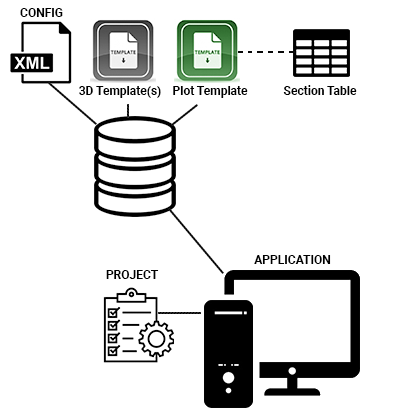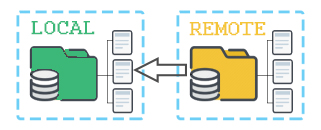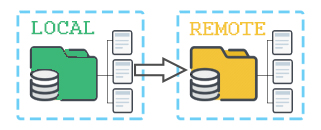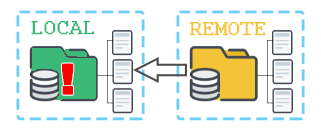Configure Local Database

Note: this information relates to Studio Mapper's data synchronization facility. Studio Mapper can also connect to a MineTrust server for data management across your organization. Contact your local Datamine office for more information.
This article describes how to create/initialize a new Studio Mapper database, or connect your project to an existing one.
How you work with Studio Mapper depends on your database configuration. Typical scenarios are:
- You are working on a single machine and have no need to upload data to or download data from a central, shared database.
- You are working with others and need to commit the latest field data to a central field mapping database after trips to the face.
In the first scenario, you work solely with a local database. There's no need to set up a central database (although you can connect to one at any time should things change in the future). Local database settings are configured using the Settings screen. See Network Database Settings.
For the second scenario, you will still need to define a local working folder (and configuration file) but will also need to specify a central, shared folder location to which you will commit your latest data, and from which to r orme twrhiiecvhe the latest central . This CENTRAL database is defined using the Central Database screen.
This article covers the following activities:
- Create a new, empty local database.
-
Swap between different mines or areas of the current database.
-
Update a LOCAL database with latest CENTRAL database contents.
-
Completely replace LOCAL database contents with CENTRAL database contents.
To create a new, empty local database:
A local database is configured automatically when you create a new project (a new, empty database is automatically created in the local project folder).
Otherwise, you can initialize a new database from an existing project:
- Activate the Setup ribbon.
-
Select Setup >> Database.
The Settings screen displays, with the Local Database tab shown.
-
Use the browse button to choose a new Local Database Directory. This can be any empty folder on your local PC (you can make a new one if you like).
Note: You can't specify a folder that already contains data (any data).
-
Active the Mine and Area tab.
-
Define the Current Mine by clicking Manage.
The Manage screen displays.
-
Click New .
A new mine appears in the list with the default name "Mine1".
-
Click Rename and enter an appropriate mine name, replacing the previous description.
-
Click Close.
The Manage screen disappears.
-
Select your new mine name by expanding the Current Mine list.
-
Define the Current Area by clicking Manage.
The Manage screen displays.
-
Click New .
A new area appears in the list with the default name "Area1".
-
Click Rename and enter an appropriate area name, replacing the previous description.
-
Click Close.
The Manage screen disappears.
-
Select your new mine name by expanding the Current Area list.
-
Click OK.
- At the "All loaded maps will be removed..." prompt, click Yes.
Note: Creating a connection to a new database folder will not remove any contents of the previous one. You can swap back to the previous database at any time.
-
Active map views are removed and the Mapping Task Bar updates.
The new, default structure will be revealed in the Project Data control bar for the currently active mine and area.
To assign another existing local database to your project:
You can also swap to any existing local database to access map contents within:
- Activate the Setup ribbon.
-
Select Setup >> Database.
The Settings screen displays, with the Local Database tab shown.
- Browse for or manually enter a fully-qualified path to an existing database folder.
- Active the Mine and Area tab.
- Select the Current Mine containing the data to be accessed.
- Select the Current Area containing the data to be accessed.
-
Click OK.
The current database connected is stopped and new database contents are loaded. The loaded structure will be revealed in the Project Data control bar for the currently active mine and area.
Note: If you are working with a central-local database arrangement, it is expected that a centrally-stored configuration file is made available locally using the synchronization options on the Central Database panel, although this doesn't have to be the case and you can specify an independent configuration file for your local projects if you wish, using the Local Database panel.
Warning: Whilst self-contained projects (that is, projects that incorporate their own local database) can be relocated to a different folder location, care should be taken if other projects link to it as the remote projects will no longer be able to access it.
To swap between different mines or areas of the current database:
- Activate the Setup ribbon.
-
Select Setup >> Database.
The Settings screen displays, with the Local Database tab shown.
- Active the Mine and Area tab.
- Choose a new Current Mine.
- Choose a new Current Area.
- Click OK.
To update a LOCAL database with latest CENTRAL database contents:

Warning: With this procedure, newer files on the central database will potentially overwrite older ones on the local database
- Activate the Setup ribbon.
-
Select Setup >> Database.
The Settings screen displays, with the Local Database tab shown.
-
Check that your Local Database Directory contains data to be updated. If not, browse for the relevant database folder.
-
Expand the Central Database menu.
-
Select the Central Database screen.
-
Ensure your Central Database Directory describes a network path to the central data store you are expecting. If the folder isn't available (say, the remote folder doesn't exist, or network issues are preventing it from being accessed), the path is shown in red, meaning you will be unable to update your local database. You'll need to resolve these issues before you continue.
- Choose what you want to update locally (if newer files exist).
- To update your local configuration file with the one on the server, select Configuration files.
-
To update your mapping data with the latest available on the server, select Mine Files and;
- Expand the Mine drop down list to choose specific mine data to update, or select <All mines> to consider all mines when updating local data.
- If a specific Mine is chosen, choose a specific Area to update, or select <All areas> to consider all areas when updating local data.
-
If data updates are time-sensitive, you can choose to only update your local database with files on the central database modified from a specific (inclusive) date onwards.
For example, if you're only interested in central database changes made since November 1st 2020, check Only files modified since and pick 01/11/2020 from the date picker. Files on the central database that were modified before this date will be ignored.If Only files modified since is unchecked, all data files of the selected scope will be reviewed when applying updates.
- Consider making a copy of your local database at this point. You can do this by duplicating the target data folder on disk.
-
Click Update Local Database. Files on the central database that are newer than local files that pass the constraints specified (if any) will be copied to your local system, overwriting those already there.
Note: New files may be added to your system but existing files that are on your system (but not on the central database) will not be removed, even if they don't exist on the server.
- Click OK to return to your local project, running with the latest data.
To update a CENTRAL database with new LOCAL database contents

Warning: With this procedure, newer files on the local database will potentially overwrite older ones on the central database, and be accessible to other team members.
- Activate the Setup ribbon.
-
Select Setup >> Database.
The Settings screen displays, with the Local Database tab shown.
-
Check that your Local Database Directory contains data to be updated. If not, browse for the relevant database folder.
-
Expand the Central Database menu.
-
Select the Central Database screen.
-
Ensure your Central Database Directory describes a network path to the central data store you are expecting. If the folder isn't available (say, the remote folder doesn't exist, or network issues are preventing it from being accessed), the path is shown in red, meaning you will be unable to update your local database. You'll need to resolve these issues before you continue.
- Choose what you want to update remotely (if newer files exist).
- To update your remote configuration file with the one on the local machine, select Configuration files.
-
To update your remote mapping data with newer data on your local machine, select Mine Files and;
- Expand the Mine drop down list to choose specific mine data on the server to update, or select <All mines> to consider all mines when updating server data.
- If a specific Mine is chosen, choose a specific Area on the server to update, or select <All areas> to consider all areas when updating server data.
-
If data updates are time-sensitive, you can choose to only update your central database with files on the local database modified from a specific (inclusive) date onwards.
For example, if you're only interested in local file changes made since November 2st 2020, check Only files modified since and pick 02/11/2020 from the date picker. Files on the local database that were modified before this date will be ignored.If Only files modified since is unchecked, all local data files of the selected scope will be reviewed when applying updates.
-
Click Update Central Database. Files on the central database that are older than local files that pass the constraints specified (if any) will be updated to match your local content.
Note: Files on the server that aren't found on your local system (for the specified scope) are not removed with this function.
- Click OK to return to your local project. Other database members can now access your latest changes.
To completely replace LOCAL database contents with CENTRAL database contents

Warning: This option will forcibly
update your local project folder with a full or partial clone
of the CENTRAL database, deleting any local files not found
at the remote location.
Datamine recommends you make a copy of your local database
before you perform this procedure.
- Activate the Setup ribbon.
-
Select Setup >> Database.
The Settings screen displays, with the Local Database tab shown.
-
Check that your Local Database Directory contains data to be replaced. If not, browse for the relevant database folder.
-
Expand the Central Database menu.
-
Select the Central Database screen.
-
Ensure your Central Database Directory describes a network path to the central data store you are expecting. If the folder isn't available (say, the remote folder doesn't exist, or network issues are preventing it from being accessed), the path is shown in red, meaning you will be unable to update your local database. You'll need to resolve these issues before you continue.
- Choose what you want to replace locally (regardless of local file modification dates).
- To replace your local configuration file with the one on the server, select Configuration files.
-
To replace your mapping data with the latest available on the server, select Mine Files and;
- Expand the Mine drop down list to choose specific mine data to replace, or select <All mines> to consider all mines when updating local data.
- If a specific Mine is chosen, choose a specific Area to replace, or select <All areas> to consider all areas when updating local data.
-
If data updates are time-sensitive, you can choose to only replaceyour local database with files on the central database modified from a specific (inclusive) date onwards. For example, if you're only interested in central database changes made since November 1st 2020, check Only files modified since and pick 01/11/2020 from the date picker. Files on the central database that were modified before this date will be ignored.
If Only files modified since is unchecked, all data files of the selected scope will be reviewed when applying updates.
- Consider making a copy of your local database at this point. You can do this by duplicating the target data folder on disk.
-
Click Replace Local Database. Files on the central database, regardless of their modification date will replace equivalents found in the local database.
Warning: This can potentially overwrite newer, local file changes with central database contents.
Local files that do not exist on the server will be removed with this activity. - Click OK to return to your local project.
Related Topics and Activities

